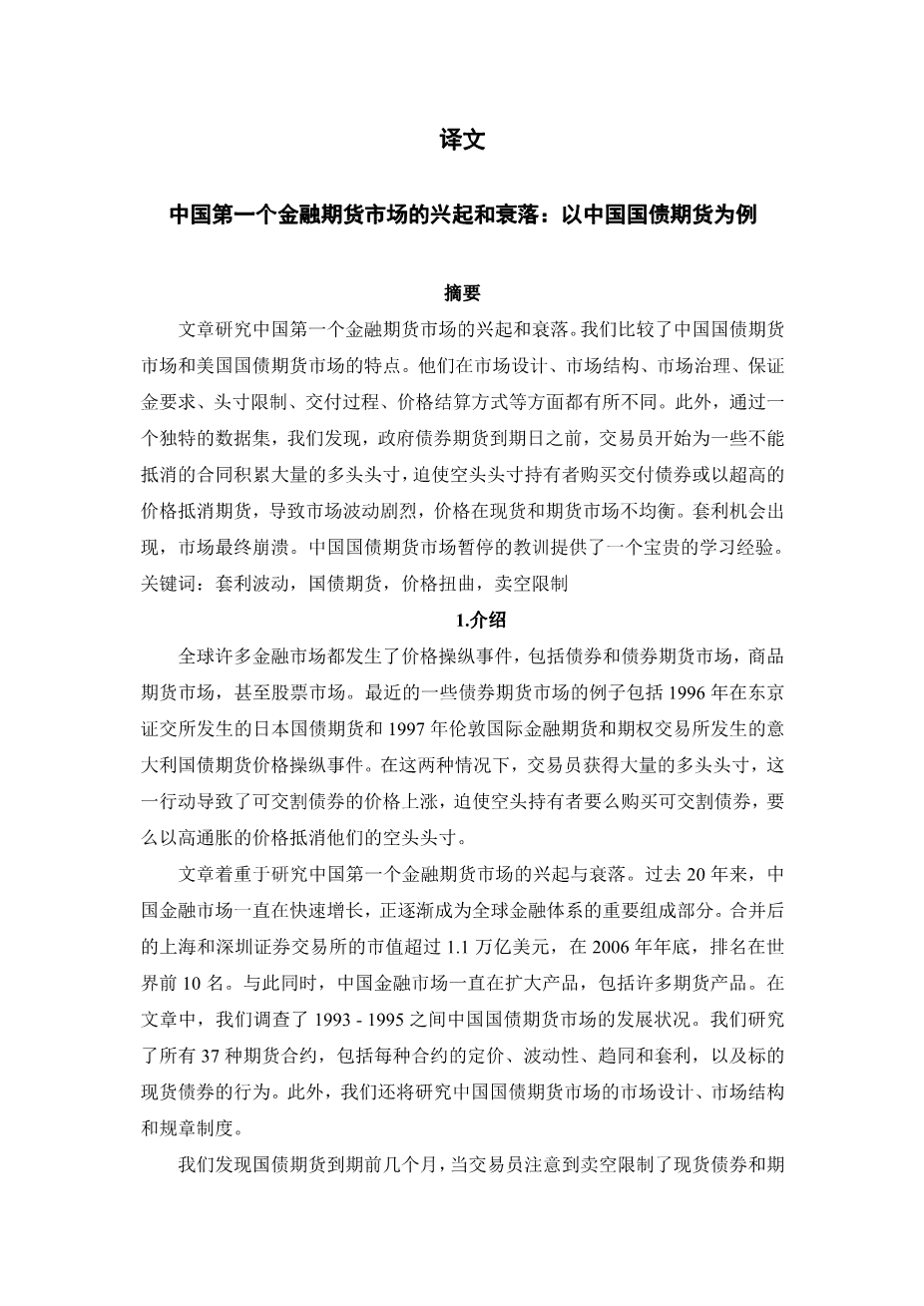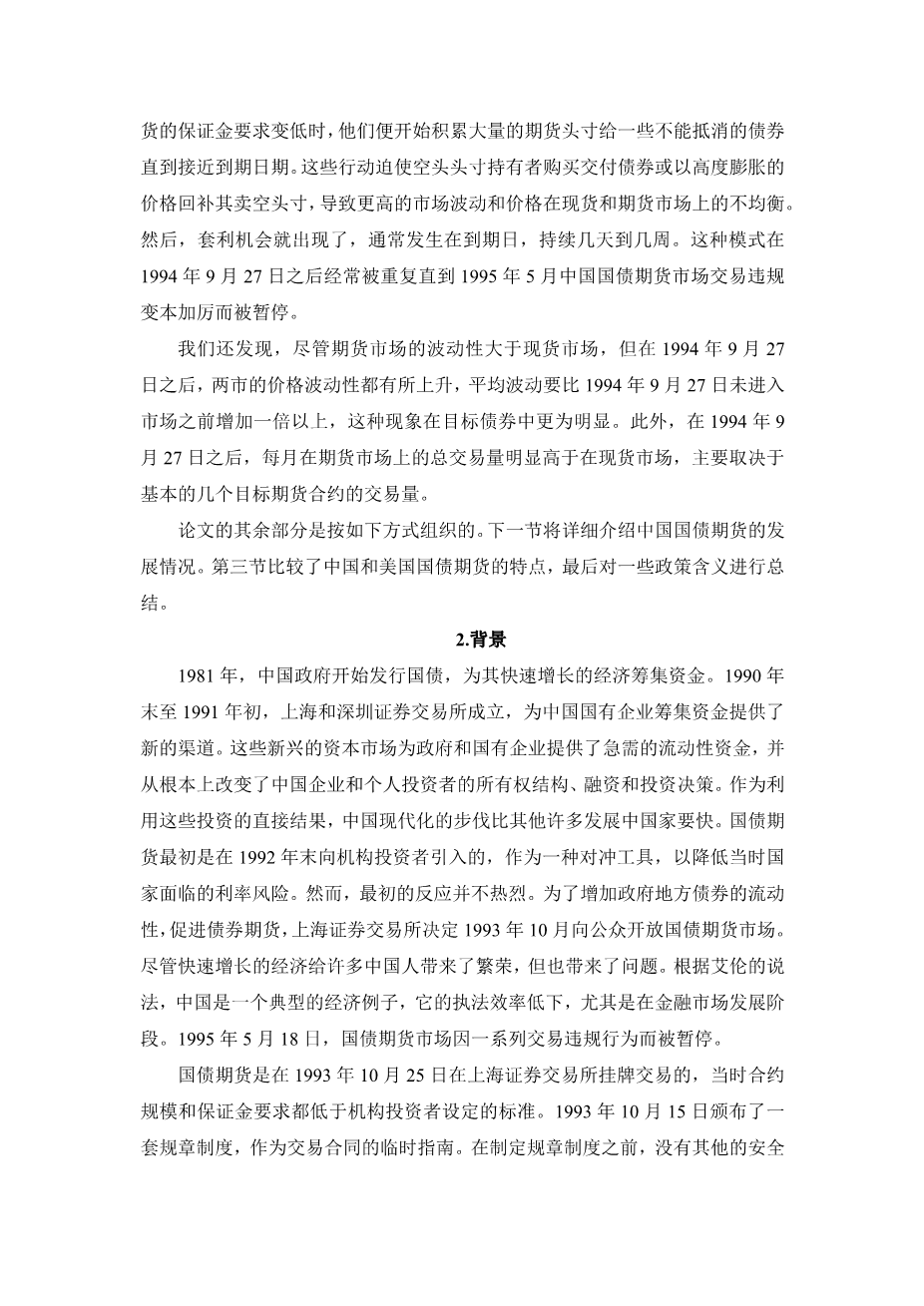Rise and Fall of the First Financial Futures Market in China: The Case of Chinese Government Bond Futures
Chao Chen, Zhong-guo Zhou*
Abstract
This paper studies the rise and fall of the first financial futures market in China. We compare the characteristics in the Chinese Government bond futures market with those in the US T-bond futures market. They differ in market design and structure, market governance, margin requirements, position limits, delivery process, and the way in which the settlement price is calculated. Furthermore, with a unique dataset, we show that prior to maturities of government bond futures, traders began to accumulate significant amounts of long positions for several selected contracts without the intention to offset, forcing short position holders to either purchase deliverable bonds or offset futures at highly inflated prices, causing higher market volatility and price disequilibrium in both spot and futures markets. Arbitrage opportunity arises and the market eventually collapses. The lessons learned from the suspension of the Chinese Government bond futures market offer an invaluable learning experience.
Key words: arbitrage volatility, Government bond futures, price distortion, short-selling restriction
JELcodes:G13,G14,G18
I. Introduction
Episodes ofpricemanipulation have occurredin manyfinancialmarketsworldwide, including
bond and bond futures markets, commodity and commodity futures markets, and even equitymarkets. Some recent examples in bond futuresmarkets include pricemanipulations of the Japanese Government bond futures in the Tokyo Stock Exchange in 1996 and the Italian Government bond futures in the London International Financial Futures and Options Exchange in 1997. In both cases, traders acquired substantial amounts of long positions for a few selected contracts and a sizeable fraction of the cheapest-to-deliver issues. This action caused the price of deliverable bonds to rise and forced short position holders to either buy deliverable bonds or offset their short futures positions at highly inflated prices.
Earlier theoretical work on futuresmarkets has focused on market design, trading rules, and integrity after a series of price manipulations in the marketplace, such as the activities engaged in by the Hunt brothers in the silver market between 1979 and 1980. Such studies emphasize the importance of regulations (e.g. Anderson, 1984), margin requirements and market integrity (e.g. Figlewski, 1984a) and the inability of a legal system to reduce/prevent pricemanipulation (e.g. Edwards and Edwards, 1984).Most empirical research has focused on the behavior of pricemanipulations in different financial markets, including analyses on price distortion of the 30-year US T-bonds byCornell and Shapiro (1989), attempted corners of individual stocks by Jarrow (1992), Salomon’s squeeze of US T-note auctions by Jegadeesh (1993), numerousmarket manipulations of theChicagoBoard ofTrade byPirrong (1995), and price squeeze of theNovember 2009 callable US T-bonds by Jordan and Kuipers (1997). Merrick et al. (2005) investigate the trading behavior of several major market participants in an attempted delivery squeeze on a bond futures contract traded in London. Using cash and futures trades of dealers and traders, they identify strategic trading patterns in a market manipulation setting and showhowlearning takes place in themarketplace and how squeezes are accomplished with severe price distortion.
The present paper focuses on the rise and fall of the first Chinese financial futures market. Chinese financial markets have been growing at a rapid pace over the past two decades and are becoming an important part of the global financial system. The combined market value of the Shanghai and Shenzhen Stock Exchanges exceeded US$1.10tn at the end of 2006, ranking among the top 10 in the world.Meanwhile, Chinese financialmarkets have been expanding their products, including many futures products. In this paper, we investigate the evolution of the ChineseGovernment bond futuresmarket during the period 1993–1995.We examine all 37 futures contracts, including the patterns of pricing, volatility, convergence and arbitrage for each contract, along with the behavior of the underlying spot bonds.We also look at themarket design, market structure, and rules and regulations of the ChineseGovernment bond futures market.
We find that several months prior to government bond futures maturing, long traders, noticing short-selling restrictions on spot bonds and low margin requirements on futures, began to accumulate significant amounts of futures positions for several targeted issues without the intension to offset even as maturity dates approached. These actions forced short position holders to either purchase the deliverable bonds or to cover their short positions at highly inflated prices, leading tohigher market volatility and price disequilibrium in both spot and futures markets. Arbitrage opportunities then arose, often occurring during the maturitymonth and lasting for several days to several weeks. This pattern was repeatedmore often after 27 September 1994when the first trading irregularity in the Chinese Government bond futuresmarket occurred and it was even more severe inMay 1995, before the market was suspended.
We also find that although the futures market tends to be more volatile than the spot market, price volatility increased in both markets after 27 September 1994. The average volatility was more than doubled after 27 September 1994 for the contracts that were introduced into themarket before 27 September 1994 and werematured after that date. This phenomenon wasmore evident for the targeted contracts. In addition, themonthly aggregate trading volume in the futuresmarket after 27 September 1994 was significantly high
剩余内容已隐藏,支付完成后下载完整资料


英语译文共 6 页,剩余内容已隐藏,支付完成后下载完整资料
资料编号:[484083],资料为PDF文档或Word文档,PDF文档可免费转换为Word
以上是毕业论文外文翻译,课题毕业论文、任务书、文献综述、开题报告、程序设计、图纸设计等资料可联系客服协助查找。


